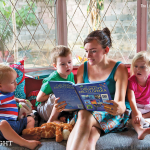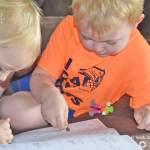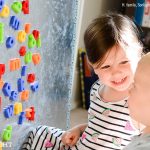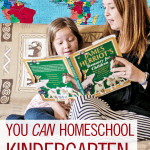Homeschooling kindergarten is tricky only when you overthink it. Trust your curriculum, focus on the basics, take cues from your child, use lots of repetition, and cultivate a love for learning. Those are the basics!
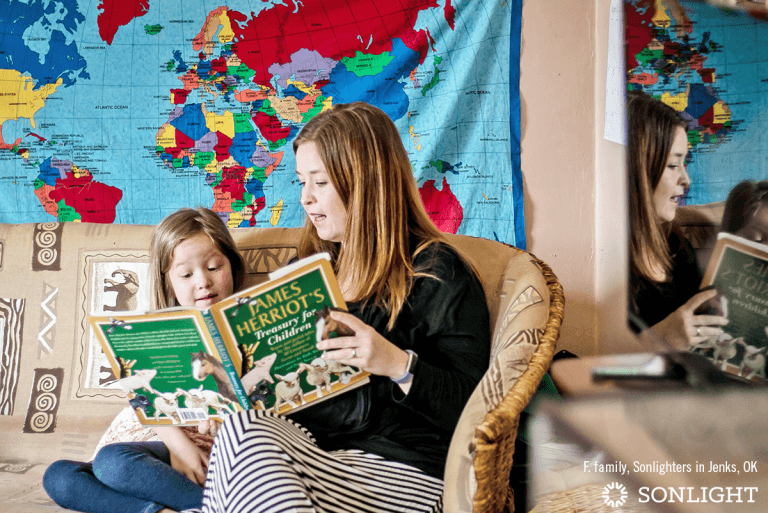
Between church activities, my time spent teaching in public school, and my time spent homeschooling, I’ve taught children almost my whole life. I’ve birthed three children. I’ve adopted one. There isn’t much that scares me about children anymore.
There is just one thing that scared me to death—teaching kindergarten. I mean, kids start learning to read in kindergarten. It’s kind of a big deal.
I was so terrified of kindergarten that we sent two of my children to public school for kindergarten and I had no plans to change my no-kindergarten policy.
But then my youngest came along, and isn’t it just like the youngest child to throw a kink in all of your tested-and-tried plans? Because my youngest daughter’s birthday fell late in the year, she just missed the cutoff for public school. But, she was ready—very ready—to start school. So we decided to do the thing that I had never done before, to homeschool kindergarten.
I have to say that over the course of that year, kindergarten became one of my favorite ages, and I no longer fear it. I don’t think that you should fear it either. Homeschooling kindergarten is all about doing a few things really well.
1. Kindergarten Structure
Kindergarten is the year you want to work on getting your children used to the flow and structure of a school day. If you’ve already been doing preschool, you will simply build upon that existing structure. But, if your child is new to school, you’ll need to establish a routine for the day. That does not mean that every minute of the day is scheduled. Rather, it means that each day is predictable and has a clear flow.
I would caution against waking up one day to implement a full daily routine. You’ll want to ease into the transition of a school day routine. The first week, work on your morning routine. As your children get used to it, gradually add more elements of the routine until you find yourself with a full day.
A simple daily flow to work toward through the year might look something like this:
- Morning Chores
- Couch Subjects
- Recess
- Snack & Read Aloud
- Table Subjects
- Lunch
- Nap
Kindergarten days should be fairly simple with plenty of time to explore and play. You will find that your daily structure is vastly different than the family down the street because each family has its own dynamics. Schedule your routine to reflect your family. The main idea here is a predictable routine that the child can depend on each day.
2. Kindergarten Basics
We all make the mistake of wanting to study quantum physics with our first child, and even sometimes our second, third, or fourth! Resist the urge to force feed education at this age.
You need a laser focus on the basics during kindergarten. Think reading, writing, and arithmetic, and for us, Bible study. You will sprinkle in art and nature naturally, so don’t get wrapped up in that. I highly recommend you read Ruth Beechick’s The Three R’s book to help you get started.
Sonlight's History / Bible / Literature (HBL) A is a fantastic place to begin in kindergarten. The Language Arts Activity Sheets contain just the right amount of practice to get your child on the right course, and the books are colorful, fun, and full of great themes for age-appropriate discussion. For math, I would recommend a simple curriculum such as Math-U-See or Singapore Math. Trust the curriculum you choose and allow it to be your guide for the year.
As you go through HBL A, you’ll notice several arts and crafts ideas as well as nature activities suggested throughout the Instructor’s Guide. If you get to them, great! If you don’t get to them, you can save them for another day or skip them altogether. Either way will be just fine.
3. Kindergarten Memorization
A huge part of the younger years is making the most of young children's amazing ability to memorize. Kindergartners are like little sponges, soaking up every bit of information you give them. When I homeschooled my daughter for Kindergarten, we did daily memorizing, including Bible verses, letter sounds, songs, short poems, etc.
Some days I offered an M & M for each item she said perfectly. Other days I held memory challenges to see who was better at reciting—my child or me! There are a plethora of really fun ways to memorize. Just be sure you tap into your kindergartner's budding talent of memorization.
4. Above All, a Love for Learning
The best piece of advice I can give for kindergarten is to encourage your child to develop a love for learning. Pay attention to your child’s cues. When they are tired, put the pencil away for a while. Play games. Go outside often. Make sure your child knows that learning comes from everywhere, not just books; the world is their classroom.
Raise a child who loves to learn, and you have raised a child who can do anything. Learning gaps can be quickly closed by a curious child.
Whatever you do, make sure that learning does not become a chore. If they moan and groan every time you pull out schoolwork, maybe they would benefit from an extra year of preschool. As a homeschooler, you are not on anyone else’s timeline. So, take your cues from your children, and don’t push too hard too early.
After teaching my youngest child through her kindergarten year, I realized that kindergarten was absolutely delightful and probably one of my favorite grades to teach. Since teaching my daughter, I’ve had the pleasure of teaching other kindergartners in our homeschool co-op, and I have loved every minute.
K-ers are so fun and so eager to get started learning. As you can tell, teaching kindergarten really isn’t so bad! It’s only tricky when you overthink it. Trust the curriculum, focus on the basics, take cues from your child, use lots of repetition, and cultivate a love for learning. Do these simple steps and you’ll be a Kindergarten homeschool extraordinaire! You’ll probably be like me and wonder why you were ever afraid of homeschooling your kindergartner.
If you need help choosing the best program for Kindergarten, we have Advisors who can help! Click here to schedule an appointment.




